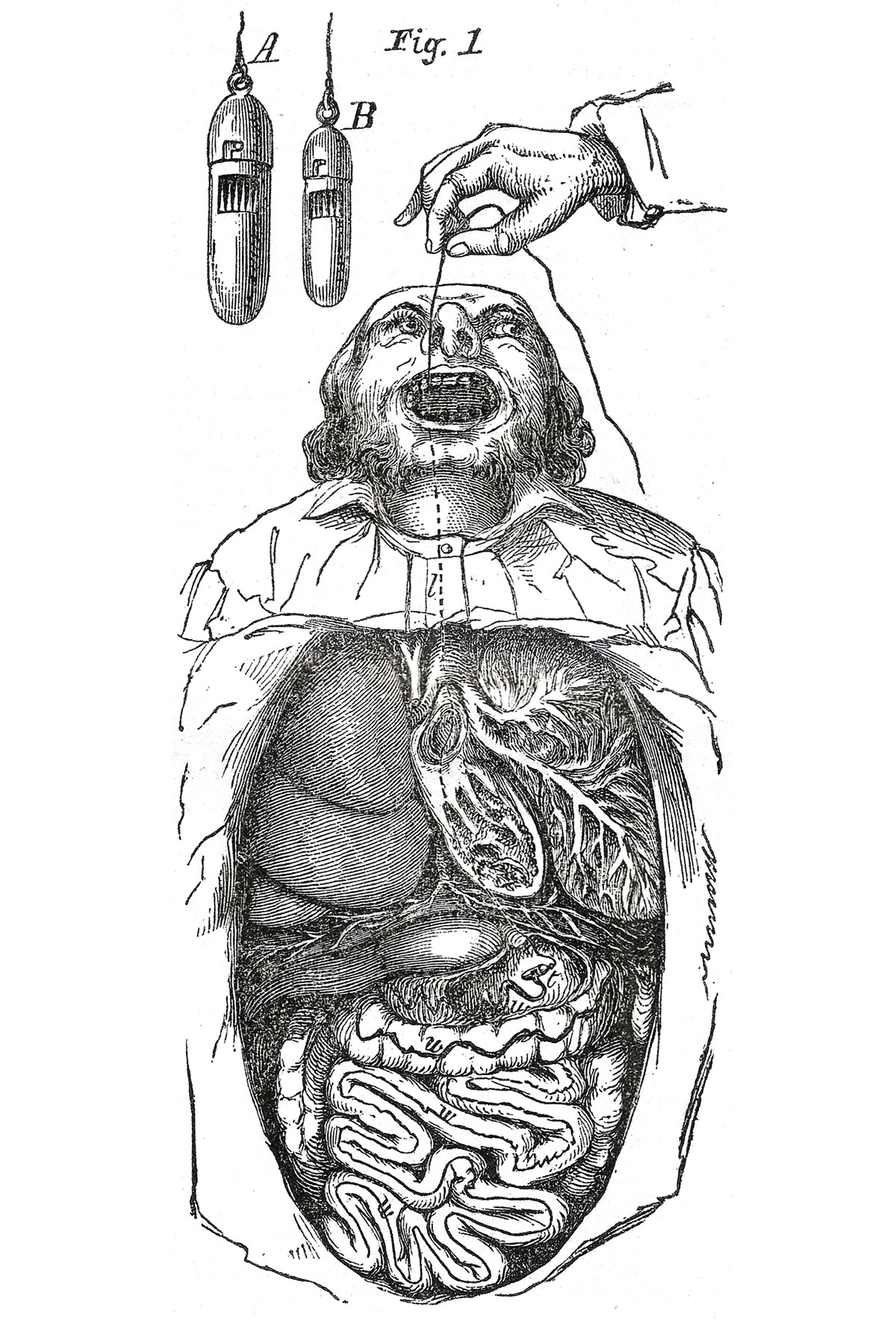Ingestion / The Beast Within
The tale of the tapeworm
Natalie de Souza
“Ingestion” is a column that explores food within a framework informed by aesthetics, history, and philosophy.
Of the menagerie of creatures that humans carry around in their guts, tapeworms are perhaps the most infamous. Arguably our hungriest intestinal inhabitant, the parasite can grow to several meters and accompany its human host for decades.
The tapeworm is, in a sense, an old friend. By the Pleistocene Epoch, before the origin of modern humans, our forebears are thought to have already acquired a proto-tapeworm from the flesh of animals they hunted or scavenged. But our history together has hardly made us easy companions. Known since antiquity (Taenia, from Greek for “band,” were recorded by Hippocrates), the worm prompts both scientific inquiry and myth making, not to mention creative techniques for exorcism, to this day.
Tapeworms are finely honed eating and reproducing machines. They attach themselves to the wall of the small intestine with their scolex—a varied apparatus of hooks and suckers—and the rest of the body, the ribbon-like strobila, floats free. As digested food passes through the gut of the host, nutrients are absorbed through the skin of the worm. Reproduction is equally streamlined. Tapeworms are hermaphrodites; each of their segments, or proglottids, bears both male and female parts, and thus fertilization does not require a partner. The segments at the free end of the worm are the most mature and often full of eggs. Eventually, these detach and pass—frequently undetected but, distressingly, sometimes not—out of the body.
Tapeworms constitute a vast family, and only a few species routinely call the human gut home. Even these spend part of their lives in another animal host, which they come to inhabit when it ingests the eggs previously excreted by the human host. The eggs hatch in the animal’s intestine, the embryos burrow through the intestinal wall, and then they travel to the flesh or organs, where they form cysts. When a human eats such cysts in meat that has not been well cooked, the cycle can now be completed. The embryos develop into adult worms and settle in, often for years. For most of the common human tapeworms, the eggs cannot become cysts in the human host; similarly, the cysts cannot develop into adult worms in the non-human host.
The beef tapeworm, Taenia saginata, is the most widespread. It is probably what the legendary soprano Maria Callas carried, on account of her fondness for rare meat. Whether this contributed to her dramatic weight loss in the 1950s, and whether she intentionally swallowed the parasite for this purpose, has been much debated. Callas is said to have denied intentionally infecting herself, though the fact that she did at some point have a tapeworm is largely held to be true.
However, even a very large worm—Taenia saginata is on average five meters long—would probably not cause significant weight loss. More typically, intestinal tapeworms deplete their host of micronutrients such as vitamins. One parasite, Diphyllobothrium latum—a fish tapeworm that is the largest to routinely inhabit the human gut, easily reaching ten meters—causes no more than a vitamin B12 deficiency and an accompanying anemia. Formerly most prevalent in Scandinavian countries, where both the eating of raw fish and the decanting of raw sewage into lakes were frequent, the fish tapeworm began to appear in the United States in the nineteenth century, among Scandinavian immigrants around the Great Lakes and the Jewish population in New York city. The anemia it caused was called “Scandinavian housewife’s disease” or “Jewish housewife’s disease”; it is likely that these hosts were at particular risk for acquiring Diphyllobothrium due to a tendency to taste the fish balls or gefilte fish during preparation, often while still quite raw.
Appalling though it might seem to be carrying a ten-meter worm in one’s innards, it is only the pork tapeworm, Taenia solium, that presents a real hazard to humans. This is because, for this worm, humans can serve not only as hosts for the adult intestinal beast, but also for the immature forms, which generate potentially dangerous cysts in organs other than the intestine. That is, if a person eats the eggs of Taenia solium, through contact with either their own or another human’s egg-infested feces, the eggs hatch as a consequence of conditions encountered as they pass through the stomach and the upper intestine. The released Taenia solium embryos can then burrow into the body and form cysts under the skin, in the muscle, in the liver, and even in the brain. These are not necessarily a problem; some people with such cysts remain asymptomatic. But if the cysts grow large enough, provoke inflammation, or occur in a critical spot, they can be harmful. Even in the early 1990s, tens of thousands of deaths a year, in all likelihood an underestimate, were attributed to neurocysticercosis, caused by pork tapeworm cysts in the brain. It is no surprise that this occurs predominantly in countries where people are often poor and where pigs mostly run free—in Latin America, Asia, and Africa.
The life cycle of the typical tapeworm—the immature form in the animal giving rise to the adult worm in the human—was understood only in the mid-nineteenth century. Although the theory of spontaneous generation had by then been challenged, and had essentially been discarded for other lower animals, some early parasitologists continued to hold the view that the intestinal worm arose spontaneously. Others believed, also erroneously, that it arose from the ingestion of free-living worms. The cysts in the flesh of animals–bladder worms as they were then called–were known, but they were considered either a different creature entirely, or a dead-end form, a degenerate tapeworm that had “gone astray.” It was not until the 1850s and the experiments of Friedrich Küchenmeister, a German doctor in Zittau, that the relation between these two forms of the tapeworm became clear.
Dr. Küchenmeister–whose name, delightfully, translates as “kitchen-master”—fed cysts from rabbits and hares to dogs and found that the dogs developed worms. He fed cysts from dogs to sheep and found that the sheep also developed worms. And in 1855, in experiments for which he is probably best known and occasionally reviled, he fed cysts from pork to two convicted criminals who later faced the hangman, and found, upon autopsy, that the dead men too had worms. Like all good experiments, this settled the debate.

Around the time that Küchenmeister was conducting his experiments, Alpheus Myers, a doctor in Logansport, Indiana, had designed and patented a tapeworm trap, “a neat, small instrument,” reported Scientific American in 1855, “made of very thin sheet gold or silver” and baited with “any nutritious food, such as a piece of cheese.” The afflicted person was made to fast for several days, supposedly causing the hungry tapeworm to draw itself out of the intestine and into the stomach, looking for food. The person then swallowed the trap, which was attached to a silk thread, and rested for some hours. During this time, the worm, it was hoped, would attack the cheese and, as a consequence of the expected wriggling, would trip a coiled spring and thus be “transfixed.” Then, “by careful and gentle drawing up of the trap, the worm is extracted with it, and gently wound round a spool or quill.”
In his firm instructions that the extraction be gentle, and in the specific design of the trap to immobilize but not sever the worm, Myers emphasized the removal of the whole animal. But he got it a bit wrong, apparently not realizing that it is the head of the worm, the scolex, that it is vital to remove.
It is, for that matter, highly unlikely that Myers’s trap would work. The trap is based on a view of the parasite as a more conventional animal, one with a mouth, an appetite, and a fondness for delicacies, and is similar, in this sense, to the many folk techniques promoted for ridding the body of a worm. Place a bowl of milk outside the body–the recommended orifice varies–and wait, hammer in hand, until the animal emerges. Feed the worm a regular diet of meat or biscuits daily–in this case inserting them into the nether orifice–and then, on the designated day, withhold its feed and wait, again hammer in hand. But a tapeworm almost certainly does not smell these foods, nor can it eat them in solid form. Nonetheless, Dr. Myers is reported in 1857 to have performed a “triumph of angling” on Mrs. E. Ryan of nearby Fort Wayne, when he used his trap to remove from her a “snake about three and a half feet long and one and a half inches in diameter.”
Among folk remedies to eliminate the tapeworm, the effectiveness of herbal and plant extracts seems significantly more likely. To this day, the ciarmavermi of rural Sicily, healers who specialize in driving out worms, use decoctions of the male fern (Dryopteris filix-mas), a toxin and anti-helminthic known since ancient times. Inevitably, in the mountains of Sicily, ritual incantations and prayers to the appropriate saint accompany the use of the drug. Seemingly infinite variations on the theme of garlic are commonly reported for this purpose as well—though the claim that even just sniffing garlic drives the disgusted worm out of the body is unlikely to be correct—and pumpkin seeds, turpentine, and the bark of the pomegranate tree are also reported to be effective.
Modern medicine has converged on a few reliable anti-helminthics—praziquantel, niclosamide, and albendazole—but the agents that have been reportedly used as vermicides through history are many. Those mentioned here are only a small selection. To quote Küchenmeister himself, “if the multitude of remedies recommended for any disorder is an evidence of their want of power against it, we must say that the therapeutics of the tapeworm is extremely defective.” Or perhaps it is simply better to have many possible ways to slay the beast within.

Natalie de Souza is an editor of Nature Methods in New York. Her most recent stint in the laboratory was at Columbia University, where she worked on cell fate specification in nematodes.